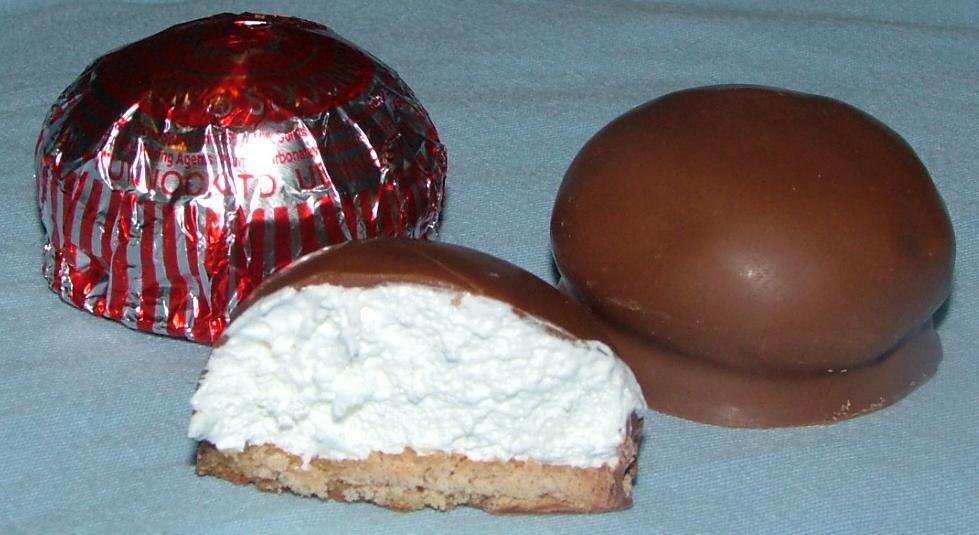The Problem With Flying With Marshmallows
Pictured above is a flødeboller, a Danish confection created in or around 1901. You’re probably familiar with them or something like them, under the name “chocolate teacakes” if you’re in the UK, Americans (typically in the New York area) know them by the brand name Mallomar, and some other places call them “whippets.” In other places, they’re simply called chocolate-coated marshmallow treats, and regardless, the basic idea is the same: it’s a marshmallow on a cookie base, all covered in chocolate.
And they can be deadly if you’re preparing for war.
Chocolate teacakes — we’ll use the British name because this is a British story — have been around for a while and became very popular after World War II rations were lifted. For those enlisted in the Royal Air Force, that was a good thing. As the Cold War expanded in the 1950s and 1960s, pilots and flight crews spent an increasing amount of time up in the skies, with many flights lasting five or even ten hours. While airborne, these crewmembers had to eat, and chocolate teacakes were often included in their rations. It made sense: they have high caloric density, making them good when space is at a premium, and they tasted great, making them welcome additions from the crew’s perspective.
But there was also a problem: the marshmallow filling.
Marshmallows are basically sugar (and, depending on where you are, egg whites), fluffed with lots of air. If you put them in a container with lower-than-normal air pressure, they’ll expand; the air inside the marshmallow tries to escape the treat, and in doing so, pushes the walls of the sugar outward, creating larger gaps. The marshmallow, as a result, grows. Here’s a video of a marshmallow in a vacuum chamber if you want to see this in action.
Planes aren’t vacuums but, as they ascend, there’s a similar effect — the higher the plane goes, the lower the air pressure. Almost all planes — both now and in the 1950s and 60s — have pressurized cabins, so you don’t experience any ill effects from this if you’re flying with marshmallows. But some of the earlier Royal Air Force planes either weren’t pressurized or weren’t fully so — and the marshmallows reflected this state of engineering. Atlas Obscura explains:
Shortly after the foil-wrapped treats appeared in RAF ration packs, pilots began to notice that as altitude increased, the teacakes expanded. At 15,000 feet, the marshmallow interior cracked the chocolate shell. Aircrews removed the teacakes from their silver foil packaging and perched them around the cabin for observation. The aerated marshmallow continued to swell as the pressure changed, and the sweets became too big to eat in one bite. Many noted that, despite the extreme physical effects, the expansion didn’t compromise the taste.
No harm, no foul, except perhaps for some cracked chocolate shells, right? Provided that the planes didn’t go much above 15,000 feet, the expanding chocolate teacakes were a fun little science experiment. And by the time planes went to higher altitudes, the marshmallows weren’t an issue whatsoever; the cabins, now pressurized, were preventing the teacakes from expanding and cracking. And if the cabin did depressurize? Well, expanding marshmallows would be the least of your problems. That’s an emergency of its own — when a plane flying at a high altitude (say, 30,000 feet) suddenly loses cabin pressure, anyone on board will likely have their ears pop, find it hard to breathe, and get very cold. Pilots only have about ten to fifteen minutes to get to a lower altitude, and they have to do so in those difficult conditions. So, flight crews in training often run depressurization drills.
Those drills, as you’d expect, are difficult. Add a rapidly-expanding chocolate-covered marshmallow to the mix? It can be deadly.
The Royal Air Force almost learned that the hard way. A 47-year veteran of the RAF, Tonny Cunnane, told the Daily Record that during a training exercise in 1965, a chocolate teacake turned into a very tasty, but still very dangerous, bomb: “As soon as the instructor captain operated the switch to depressurize the cabin, there was the expected loud bang and, as usual, the cabin instantly filled with an icy cold fog.” But what followed was, to say the least, unusual — and potentially deadly: “Chocolate and shredded marshmallow splattered all over the windscreens, the flight instruments and the pilots’ flying suits.” The chocolate teacakes had rapidly expanded and literally blew up, sending sweet shrapnel all over the place.
The crew managed to land the plane safely despite the messy distraction. The RAF removed chocolate teacakes from flight crew ration packs shortly thereafter.
Bonus fact: Are chocolate teacakes cookies or cakes? If that seems like a silly question, it isn’t — at least, not if you’re British retailer Marks & Spencer. That’s because Marks & Spencer sells a lot of chocolate teacakes, and how the treats are taxed impacted their bottom line. As the BBC explained in 2009, “Under UK tax rules, most traditional bakery products such as bread, cakes and flapjacks are free of VAT, but the tax is payable on cereal bars, shortbread and partly-coated or wholly-coated biscuits.” The retailer argued that the teacakes are cakes, not cookies (“biscuits,” in the local parlance), despite the cookie base and the chocolate coating. The courts agreed and ultimately, Marks & Spencer was given a £3.5 million ($4.5 million) refund for tax overpayments on chocolate teacake sales from 1973 to 1994.
From the Archives: The Great Choco Pie War of 2014-2015: Choco Pies are kind of like chocolate teacakes. Right?

